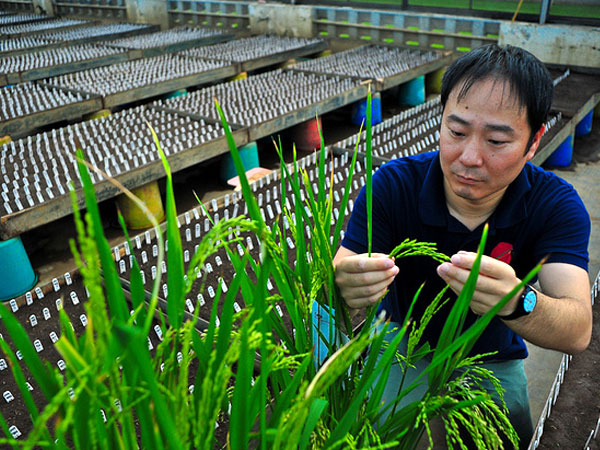Scientists discover wonder rice gene—IRRI

Dr. Tsutomu Ishimaru, IRRI rice breeder, inspects a rice plant with Spike gene. Photo courtesy of IRRI
MANILA, Philippines — Scientists have discovered a wonder rice gene that could dramatically increase yields of one of the world’s most important food crops, the International Rice Research Institute said Tuesday.
Preliminary tests show that yields of modern long-grain “indica” rice varieties, the world’s most widely grown types of rice, can rise by 13-36 percent when infused with the so-called SPIKE gene, the Philippines-based institute said.
“Our work showed that SPIKE is indeed one of the major genes responsible for the yield increase that breeders have spent so many years searching for,” IRRI genetic transformation laboratory chief Inez Slamet-Loedin said in a statement.
Testing of new rice varieties infused with the gene is under way across several developing countries in Asia, said rice breeder Tsutomu Ishimaru, head of the IRRI-led SPIKE breeding program.
“We believe that these will contribute to food security in these areas once the new varieties are released,” Ishimaru said.
Increasing the yield means growing more rice on the same amount of land, using the same resources.
But there is no definite timetable for when the rice containing the SPIKE gene will be distributed to farmers, according to IRRI spokeswoman Gladys Ebron.
The SPIKE gene was first discovered by Japanese breeder, Nobuya Kobayashi, following long-running research starting in 1989 on a tropical “japonica” rice variety that is grown in Indonesia, Ebron told AFP. The findings of the study were published Monday.
Tropical japonica rice is mainly grown in East Asia and accounts for just 10 percent of global rice production.
Breeders from IRRI, a non-profit research group established in the 1960s, then worked to incorporate the gene into “indica” varieties that are widely used in major rice-growing areas of Asia.
Ebron said the transfer did not involve genetical modification of the crop, a controversial issue in food production. “It’s just conventional breeding,” she added.
Rice is the developing world’s most important food crop, consumed by more than half of humanity, including 640 million Asians who live in poverty, according to IRRI.
To keep rice prices stable and affordable at about $300 a ton, the institute estimates production needs to increase by 8-10 million tons every year. Asia accounts for about 90 percent of global rice production, it added.
IRRI is widely recognized as having played an important role in the “Green Revolution” of the 1960s in which new varieties of rice dramatically increased yields.














